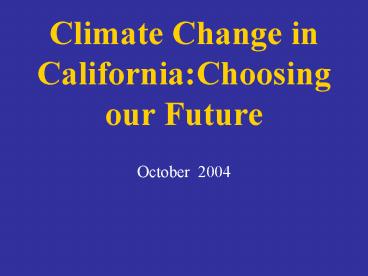Climate Change in California:Choosing our Future - PowerPoint PPT Presentation
1 / 21
Title: Climate Change in California:Choosing our Future
1
Climate Change in CaliforniaChoosing our Future
- October 2004
2
Emissions pathways, climate change, and impacts
on California Proceedings of National Academy of
Science Published in August 2004
- Katharine HayhoeATMOS Research and Consulting
- Daniel CayanScripps Institution of Oceanography
- Christopher FieldCarnegie Institution
- Peter FrumhoffUnion of Concerned Scientists
- Edwin MaurerSanta Clara University
- Norman MillerLawrence Berkeley National Lab
- Susanne MoserNational Center for Atmospheric
Research - Stephen SchneiderStanford University
- Kimberly CahillCarnegie Institution
- Elsa ClelandCarnegie Institution
- Larry DaleLawrence Berkeley National Lab
- Ray DrapekUSDA Forest Service
- R. Michael HanemannUC Berkeley
- Laurence KalksteinUniversity of Delaware
- James LenihanUSDA Forest Service
- Claire LunchCarnegie Institution
- Ronald NeilsonUSDA Forest Service
- Scott SheridanKent State University
- Julia VervilleUnion of Concerned Scientists
3
Climate Change in CaliforniaNew Projections
- What are the consequences of following markedly
divergent emissions pathways? - -- for temperature and precipitation
- -- for key climate-sensitive sectors
4
Global Emissions ScenariosIntergovernmental
Panel on Climate Change (IPCC)
5
Temperature Projections(change in temperature F)
HADCM3
Low
High
PCM
SUMMER
Low
High
Previous Midrange Projections
6
Rising Temperatures California statewide
Projected changes in average summer temperature
7
Patterns of Temperature Change2070-2099 relative
to 1961-1990Summer
LOWER EMISSIONS
HIGHER EMISSIONS
HadCM3 lower
PCM higher
HadCM3 higher
PCM lower
8
Increasing HeatwavesAdditional Heatwave
days/year2090s
9
Increasing Heat-Related MortalityAverage Annual
Deaths
10
Diminishing Sierra Snowpack Remaining, Relative
to 1961-1990
11
Precipitation ProjectionsStatewide, Winter
HadCM3 higher
PCM higher
HadCM3 lower
PCM lower
0
12
Impacts on Water Supply
13
Decreasing Wine Grape QualityTemperature Impacts
Wine Country (Sonoma, Napa Counties) Cool Coastal
(Mendocino, Monterey Counties) Northern Central
Valley (San Joaquin, Sacramento Counties)
14
Changes in Vegetation Distribution2070-2099,
relative to 1961-1990
Temperature-driven
Fire-mediated
15
California Climate Projections Summary End of
Century
- Temperature increases greater than previously
predicted - Higher emissions yield higher summer temperatures
- Higher scenario summer 8.5 to 18 F
- Lower scenario summer 3.5 to 9 F
- Heat waves 2-5 times more common, more intense,
and longer lasting - Precipitation variable, with trends towards
slight decrease
16
Impacts on Key SectorsSummary End of Century
- Substantial impacts under both emissions
scenarios - Impacts and adaptation costs increase with higher
emissions - Heat-related deaths in 5 study cities
- Increase 2-4 times in lower emissions
- Increase 3-6 times in higher emissions
- Sierra snowpack loss
- 70-90 in higher scenario and
- 30-70 lower scenario
- Lower emissions pathway is not a floor higher
emissions pathway is not a ceiling.
17
Managing Climate Change in California
- Reduce emissions of heat-trapping gases
- Transportation accounts for 49 of C02 emissions
- Electricity accounts for 30 of C02 emissions
- Minimize pressures on the environment
- reduce fire risk in forests
- Protect natural floodways
- Reduce encroachment on sensitive ecosystems
- Prepare for climatic changes that
- cannot be avoided
- Heat warning system
- Water conservation
18
Comparing Historical Observations with Downscaled
Climate Model ResultsTEMPERATURE
Observed
Statistical Downscaling
Dynamical Downscaling
Wood et al., 2003
19
Comparing Historical Observations with Downscaled
Climate Model ResultsPRECIPITATION
Observed
Statistical Downscaling
Dynamical Downscaling
Wood et al., 2003
20
Temperature (oC)
Winter
Summer
Summer Winter
21
Winter Precipitation































